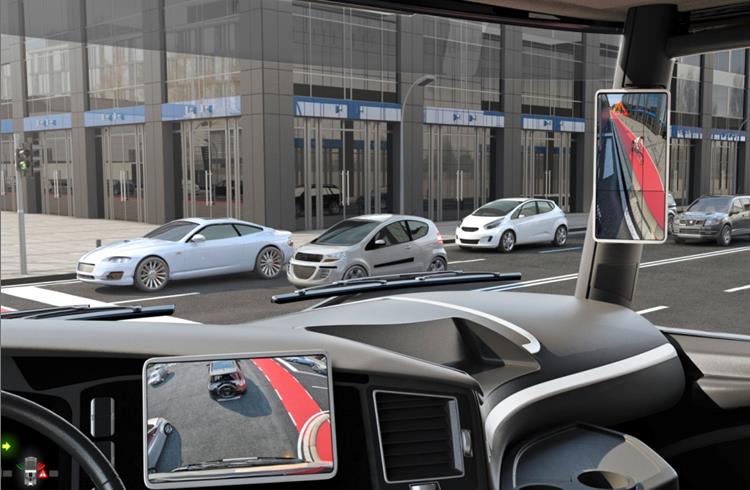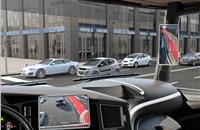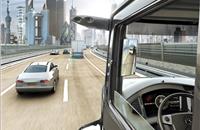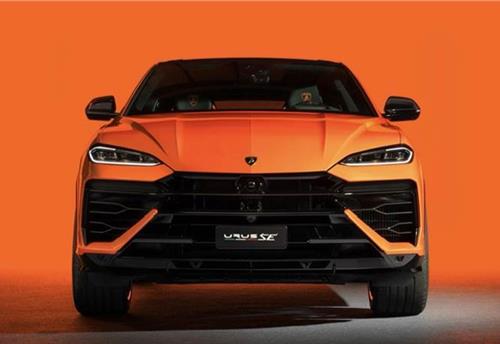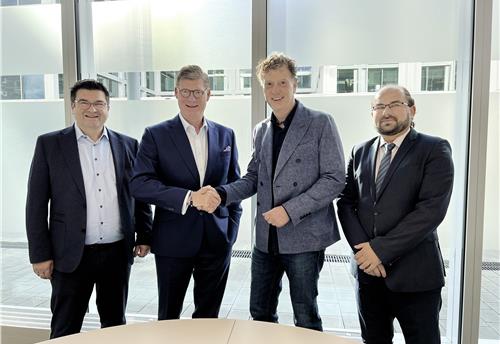Continental develops digital side-view mirror without split screen
Continental says the larger, high-resolution displays for highest image quality and detailed image reproduction will help reduce blind spots and contribute to safety
Continental has announced development of its ProViu Mirror camera monitor system which merges multiple field-of-view images from different cameras into a single image for a clearer overview.
Continental says the larger, high-resolution displays for highest image quality and detailed image reproduction will help reduce blind spots and contribute to safety. Additionally, moving the side-view mirrors to the inside of the cabin saves up to two percent fuel.
The next generation of its ProViu Mirror digital side-view mirror, has only one single image – and it’s large, seamless and intuitive for the driver. The various images from the cameras mounted on the side of the driver’s cabin are displayed on the interior displays as one single merged image by ProViu Mirror.
“Instead of a one-to-one imitation of the traditional mirror, we’re now exploiting the full potential of camera monitor systems. Thanks to the Merged View display, the driver has an even better overview of the current traffic situation. This comprehensive visual check makes a major contribution to anticipatory driving and helps prevent accidents. One major advantage of the previous version has been retained – reduced air resistance, meaning up to two percent less fuel consumption,” explains Dr. Michael Ruf, head, Commercial Vehicles & Aftermarket Business Unit at Continental.

A plus in safety: In the display on the A-pillar, Continental merges the various camera shots into one image, enabling drivers to view the entire vehicle environment. The central display shows the area of the front mirror.
How the ProViu mirror system works
In the new system two cameras are mounted on each side of the vehicle, covering the areas of the main side-view, wide-angle and close-range mirrors. The images are transmitted to two displays on the right and left sides of the A-pillar in the cabin, so the camera images are permanently in the user’s line of vision.
Until now, the different fields of view captured by the cameras were displayed as individual images, one above the other. In the new version, the developers at Continental have merged the fields of view into one single image on the display, so the driver can always see the entire vehicle environment. The danger caused by not looking at a relevant field of view at the right time and overlooking other road users or obstacles as a result is therefore reduced.
The new displays are larger and have an aspect ratio of 16:9. It has also continued to improve the image presentation: Thanks to full HD resolution, the images that the driver sees are now even more contrast-rich and detailed. The displays on the A-pillar can be optionally supplemented by a central display on the instrument panel that shows the area of the front mirror.
Continental believes that the digital side-view mirror will become even more intelligent in the future. “We have succeeded in displaying a particularly comprehensive image of the vehicle environment on the monitor, one that even exceeds the legal field-of-view requirements. This makes the driver’s work much easier,” said Tobias Schmalriede, product manager responsible for ProViu Mirror.
“In a few years’ time, the digital side-view mirror will become even more intelligent. We’re already working on our system to ensure that the driver will have the relevant fields of view and the right information at exactly the right time.”
Improved aerodynamics ensure greater efficiency
ProViu Mirror meets the legal requirements for indirect visual displays (UNECE R46), the standards for camera monitor systems in compliance with ISO 16505:2015 and the standards for functional safety for road vehicles (ISO 26262).
Continental says it will industrialise the available basic version together with interested OEMs to match the specific requirements of their series. Here the displays are adapted to the cabin’s interior, the camera arms are adapted to the external geometry of the vehicles and aerodynamic studies are carried out – because with ProViu Mirror, commercial vehicles are not only safer, but also more efficient on the road.
The installation of cameras on the geometry of vehicles also results in a major reduction in aerodynamic resistance. This advantage is also emphasised by the small size of the camera modules. Thanks to these aerodynamic optimisations, the camera monitor system can reduce fuel consumption by one to two percent, helping to optimise fleet cost efficiency and reduce environmental impact. Just one percent less fuel consumption equates with savings of around 2.4 fewer tons of CO2 per year.
RELATED ARTICLES
Lamborghini unveils Urus SE ahead of Auto China 2024
Electric-only range of 60km helps reduce emissions by 80%.
ZF to display next-gen e-axle for low-floor city buses at Busworld Turkiye 2024
The AxTrax 2 LF is available with a continuous output of up to 360 kW and a peak torque of up to 37,300 Nm.
Daimler Buses and BMZ Poland to develop next-gen NMC4 electric bus batteries
The new battery generation NMC4 – succeeding the current NMC3 technology – will combine high energy density, resulting i...





 By Autocar Pro News Desk
By Autocar Pro News Desk
 06 Dec 2017
06 Dec 2017
 7736 Views
7736 Views



